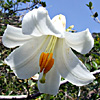One of the most beautiful plants originated in the East Mediterranean and transferred to all other parts of the world. It is a rare species that appears in only a few locations on Mt. Carmel and Upper Galilee.
This is a geophyte with a large bulb that produces in the autumn a rosette of long leaves. In the spring a tall stalk grows up carrying bright-green lanceolate leaves. It may reach more than 2 m in height. At its top there are several large fragrant flowers. The white corolla is funnel like with six pointed lobes that form the symmetrical shape of the Star-of-David. At the flower center there are 6 long stamens that release orange pollen in large quantities. Among them is the long pistil. The dry fruit slits open and disperse a large number of small seeds.
Heavy uprooting and picking in the past brought this species to the verge of extinction. Another cause of its decreased abundance is the closure of woody areas due to cessation of goat grazing that was much more common in the past. This closure reduces the amounts of light the plants receive and decrease blooming and seed production.







